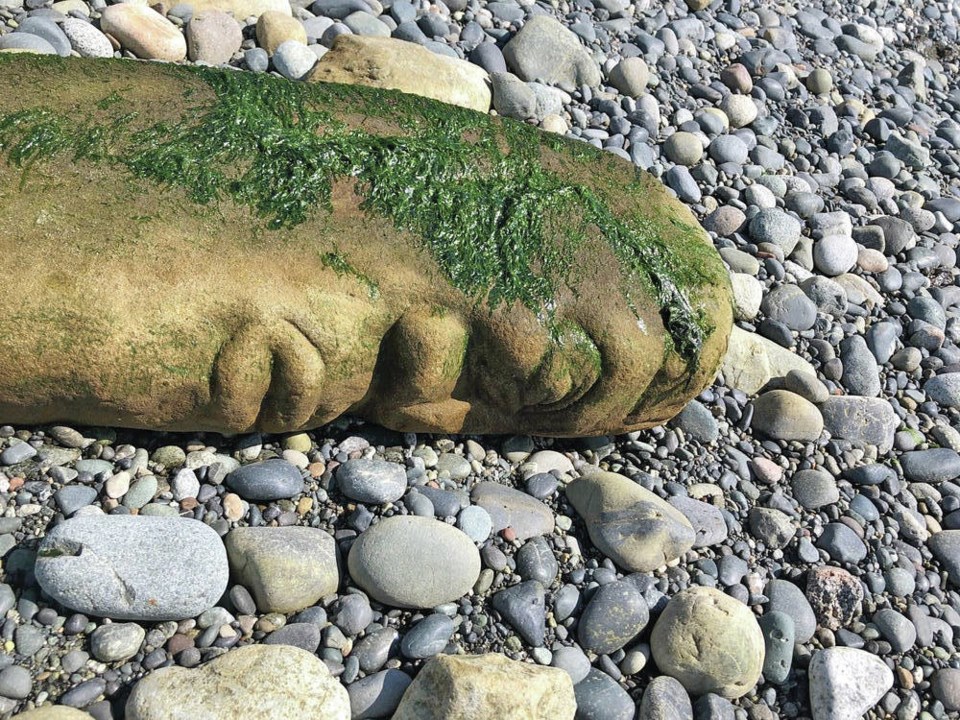A carved sandstone pillar discovered on a Dallas Road beach last summer is an Indigenous artifact once used in rituals by the Songhees and Esquimalt First Nations, says a Royal British Columbia Museum curator of archeology.
The 100-kilogram oblong pillar with a carved face on its edge was found July 12 by Victoria resident Bernhard Spalteholz while walking along the beach between Finlayson and Cloverdale points, below Beacon Hill Park.
After examining the stone, consulting with local communities and looking at anthropological records, archeology curator Grant Keddie came to the conclusion the artifact could be a ritual stone pillar, likely related to events such as the first salmon ceremony, used in puberty rites or related to ceremonies involving the feeding of the dead.
The museum said it will work with the Songhees and Esquimalt Nations to determine the most suitable home — temporary or permanent — for the find.
The artifact is a large slab of sandstone, a type of rock not found in this area, and does not appear to have been carved with steel tools, according to Keddie. He said special rocks were used by the Lekwungen people to influence the weather and ensure safety in venturing out in pursuit of food or to create unsafe conditions for one’s enemy.
One was used in Cadboro Bay as late as 1878, and another was not far from Finlayson Point.
Keddie said the stone pillar likely once stood near the more extended edge of the cliff until a large landslide took it down and eventually shifted it near its recent location.
As for why the stone was not found before, Keddie said it’s possible recent winter storms moved it or exposed the carved section. “Also, being covered in seaweed and only exposed on the lowest tide of the year, it may have gone unnoticed for many decades.”
First Nations issued statements saying they were elated by the discovery.
“It’s an exciting find and a clear reminder of the long history of our people living in this region,” said Chief Ron Sam of the Songhees Nation. “We are looking forward to learning much more about the stone.”
Chief Rob Thomas of the Esquimalt Nation said he hopes more artifacts will be found, possibly under the landslide near where the stone was discovered, or in the water just offshore. “Our hope is future discoveries may tell a fuller story of the stone’s history.”
An initial survey by two divers with the Underwater Archaeological Society of British Columbia of the area where the artifact was pulled from the beach did not immediately reveal any other significant stones or pillars.
Keddie said stone burial cairns once extended in large numbers down the slope of Beacon Hill, noting anthropologist Franz Boas mentioned ceremonies in which a girl “when reaching the age of puberty, must take some salmon to a number of large stones not far from Finlayson Point Battery,” in what appeared to be a feeding-of-the dead ceremony.
While radio-carbon dating can only be done on organic artifacts, making it difficult to date carved stones, he said oral and written histories can provide some context for important cultural artifacts. “We can, at least, suggest that this was a very special ritual stone pillar.”
Keddie said he discounted initial theories that the pillar could have been planted or was a garden ornament dumped there.
Jack Lohman, chief executive of the Royal B.C. Museum, called the pillar “a remarkable find with a remarkable story.”
He said the museum will continue working with the Songhees and Esquimalt Nations to learn more about the pillar’s cultural significance and will follow their lead regarding the future location and display of the artifact.
Keddie and research associate Tom Brown located the pillar a few days after being notified and wrestled the heavy artefact ashore from a rising tide using a log railroad. There, it was loaded onto a dolly and wheeled across plywood blanking to the stairs at the foot of Cook Street.
Keddie worked with conservation team members at the museum to stabilize and protect the integrity of the artefact, which had been immersed in seawater, with one side covered in algae. That involved changing baths of distilled water once a week to draw out any salts.
After a time in distilled water, the algae started to die. It was removed slowly with a soft bristle brush to avoid damaging the stone.
A custom mount will be made that can support its weight and keep the carved area visible and accessible for study.
dkloster@timescolonist
For more details, go to Grant Keddie’s Royal B.C. Museum blog entry: rbcm.ca/lekwungunritualstonepillar



